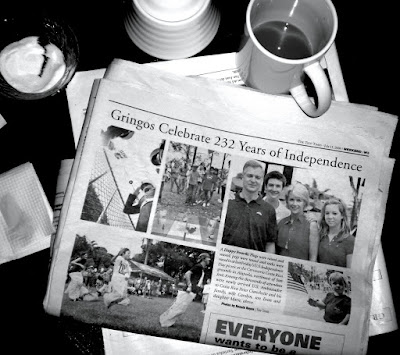
I crossed the border on foot from Costa Rica to Nicaragua.

The view from the cargo boat. We were waiting to begin our journey across Lake Nicaragua.



Ometepe, the island of the twin volcanoes

A memorial in Granada.

The FSLN flag. Many homes displayed their Sandinista pride.

One of the many buses leaving for the celebrations in Managua.
A little History
(Disclaimer: My understanding of Nicaraguan history is superficial; some of these statements may be inaccurate. I am not trying to glorify the Sandinistas nor am I claiming to support them in any way.)
(Disclaimer: My understanding of Nicaraguan history is superficial; some of these statements may be inaccurate. I am not trying to glorify the Sandinistas nor am I claiming to support them in any way.)
In 1979, the Sandinistas overthrew the Somoza government and took control of Nicaragua. After the revolution, the FSLN party (the political party of the Sandinistas), lead by Daniel Ortega, competed in national elections and won by a landslide. Although the FSLN won in what many international observers believed was a “free and fair” election, the U.S. felt otherwise.
Washington D.C. never liked the Sandinistas. Carter had backed Somoza’s violent attempts to crush the Sandinistas. When this didn’t work out, the U.S. tried again to topple the Sandinistas. Reagan began supplying the Contras (a group of exiled anti-Sandinistas) with arms and training to help topple the FSLN party. After much protest from the International Court of Justice, the UN, and other human rights activists against U.S. involvement in Nicaragua, the U.S. Congress finally passed legislation prohibiting the president from supplying any further aid to the Contras.
But Reagan (the maverick that he was) didn’t listen. He and his buddies continued to assist the Contras by illegally and covertly funneling to them third party donations and proceeds from arms sales to Iran (and began the Iran Contra fiasco). This aid, in addition to other regional political factors, eventually exhausted the Sandinistas. In 1990, the Sandinista government was officially defeated and replaced.
But now, 16 years later, Daniel Ortega has reemerged. In 2006, Ortega won back the presidential throne for the FSLN party through a “free and fair” democratic election.
My time in Nicaragua:
Understanding this history really helped me appreciate the passion and emotion I witnessed in Nicaragua during the anniversary weekend of the Sandinista Revolution.
There was a current in the air that made me realize that the chants being yelled and the flags being waved were heavy with historical memory. The older folks had a glow of reflection around them. Many spoke softly as they talked of Sandino and told stories of power and blood shed. The young boys were on fire as they took to the streets, all wrapped up in red and black. They were aching to celebrate a revolution they had grown to love through stories and memories. It was their time. As they made their pilgrimage to Managua with their family and friends, they began to take ownership of the revolution. And soon they would see Daniel Ortega, Hugo Chavez, and many others take to the stage and sing the songs of bravery, martyrdom, and revolution.
This year was different. After a very long time, the father of the FSLN had returned as the father of Nicaragua. This year, President Ortega welcomed his comrades to Managua to celebrate the 29th anniversary of their revolution.





